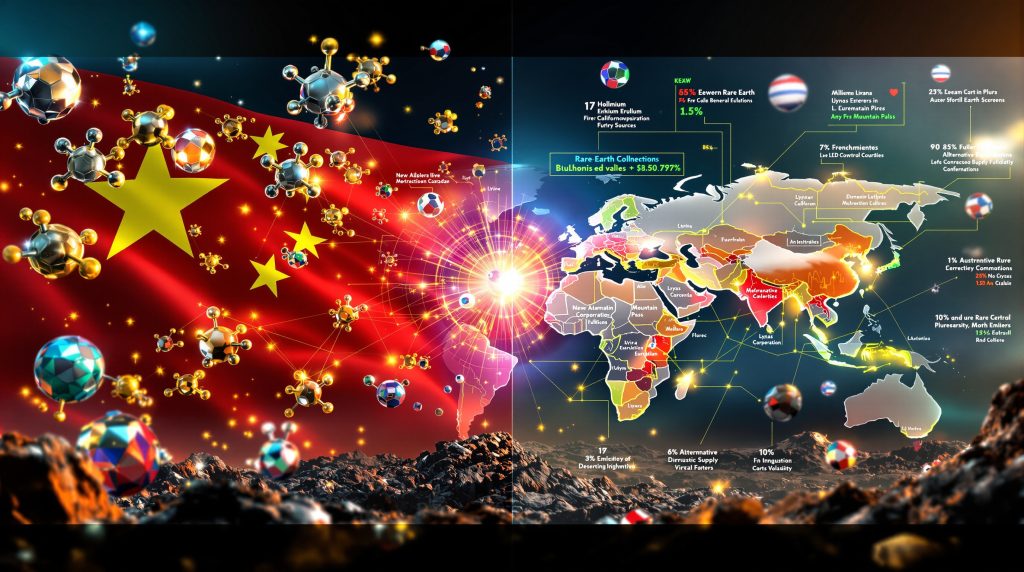China's unprecedented use of rare earth export controls has fundamentally reshaped global supply chains and international trade relationships, transforming these 17 critical minerals from obscure industrial materials into powerful geopolitical weapons. These elements, despite their modest quantities in end products, serve essential functions across automotive, aerospace, defence, and technology sectors. Their strategic importance has elevated them from niche commodities to centrepieces of international diplomatic negotiations and economic leverage.
The global dependency on these elements creates unprecedented vulnerabilities for manufacturers worldwide. Modern electric vehicles require rare earth magnets for motors, smartphone screens depend on europium for vivid displays, and defence systems rely on specialised rare earth compounds for precision guidance systems. This widespread dependency has created a complex web of international relationships where supply disruptions can cascade through entire industrial sectors within weeks.
Contemporary export control mechanisms have evolved significantly beyond traditional quota systems. Modern restrictions encompass licensing requirements, complete export bans, and sophisticated extraterritorial compliance frameworks that extend regulatory reach across international borders. These mechanisms represent a fundamental shift from purely economic trade policies to instruments of strategic influence and diplomatic leverage.
China's 2025 Export Restriction Timeline and Market Response
The escalation of Chinese rare earth export controls throughout 2025 created unprecedented disruptions across global manufacturing sectors. In April 2025, Beijing introduced initial restrictions targeting seven rare earth elements, with particular focus on magnetic materials essential for electric vehicle production. These controls immediately triggered supply shortages that forced automotive manufacturers to halt production lines at multiple facilities within weeks of implementation.
The automotive sector experienced the most immediate and severe impacts from these restrictions. Major manufacturers faced critical shortages of neodymium and dysprosium compounds necessary for electric motor magnets, creating production bottlenecks that cascaded through global supply chains. Industry sources reported that some production lines remained shuttered for extended periods while companies scrambled to identify alternative suppliers and adjust manufacturing processes.
October 2025 witnessed a significant expansion of these controls, encompassing additional rare earth elements and extending restrictions to battery manufacturing equipment and industrial diamonds. This escalation created panic conditions among foreign customers of China's battery sector, prompting companies to rush shipments before implementation deadlines. The expansion demonstrated Beijing's willingness to leverage its dominant position across multiple critical material sectors simultaneously.
However, diplomatic developments in late October introduced unexpected complexity to this trajectory. Following high-level negotiations between Chinese and American leadership, Beijing announced a one-year pause on the October restrictions, though the April controls remained operative. This selective relief highlighted the tactical nature of these policies and their use as diplomatic bargaining tools rather than permanent trade measures.
Key Elements Under Current Restrictions:
• Holmium: Essential for medical lasers and nuclear reactor components
• Erbium: Critical for fibre optic amplifiers and telecommunications infrastructure
• Thulium: Required for portable X-ray devices and specialised medical equipment
• Europium: Vital for LED phosphors and display screen technologies
• Ytterbium: Necessary for industrial lasers and precision atomic clocks
The restrictions extend beyond raw materials to encompass processing equipment and manufacturing technologies. Companies involved in rare earth mining, separation, and purification face licensing requirements for exporting specialised machinery and technical knowledge. This comprehensive approach aims to maintain China's technological advantages throughout the entire rare earth value chain.
Extraterritorial Compliance and the 0.1% Threshold Rule
The implementation of extraterritorial jurisdiction represents perhaps the most significant development in modern trade regulation. Under proposed regulations, any product containing more than 0.1% Chinese-origin rare earth content would fall under Beijing's export control authority, regardless of where final manufacturing occurs. This threshold creates unprecedented compliance obligations for manufacturers worldwide.
Companies must now implement comprehensive tracing systems to document the origin and percentage of rare earth content in their products. This requirement extends to complex supply chains where materials may pass through multiple processing stages and jurisdictions before reaching final assembly. The documentation burden represents a fundamental shift in how global manufacturers manage supply chain transparency.
Critical Compliance Challenge: Manufacturers must verify the origin of rare earth content throughout multi-tier supply chains, creating documentation requirements that extend far beyond traditional procurement practices.
Third-country processing presents particular complications under this framework. Materials processed in intermediate locations using Chinese rare earth inputs may still fall under Beijing's regulatory authority, regardless of the processing location or subsequent value addition. This extraterritorial reach challenges traditional concepts of national jurisdiction over trade activities.
The December 2025 implementation timeline for these rules creates urgent pressures for companies to audit their supply chains and establish compliance protocols. Furthermore, organisations lacking comprehensive rare earth tracing capabilities face potential disruptions to their export activities and market access.
Supply Chain Documentation Requirements
Companies must establish systems capable of tracking rare earth elements from extraction through final product assembly. This requirement encompasses not only direct suppliers but also sub-tier vendors who may provide components containing Chinese-origin materials. The complexity increases significantly for manufacturers using recycled materials, where origin determination becomes substantially more challenging.
Industry-Specific Vulnerabilities and Adaptation Strategies
The automotive sector's dependence on rare earth elements extends far beyond electric vehicle motors. Advanced driver assistance systems require specialised sensors using rare earth compounds, while hybrid powertrains depend on permanent magnet generators for energy recovery systems. The April 2025 restrictions exposed critical vulnerabilities in automotive supply chains that manufacturers had previously overlooked.
Automotive Impact Analysis:
• Production Disruptions: Multiple assembly plants experienced temporary shutdowns within weeks of restriction implementation
• Component Shortages: Critical shortages affected electric motor magnets, sensor systems, and catalytic converters
• Cost Escalation: Alternative sourcing options commanded premium pricing, increasing vehicle production costs
• Timeline Extensions: New supplier qualification processes extended product development cycles by 12-18 months
Defence and aerospace sectors face even more severe vulnerabilities due to their reliance on specialised rare earth compounds for precision guidance systems, radar technologies, and electronic warfare capabilities. These applications often require specific rare earth purities and compositions that alternative suppliers cannot readily provide, creating potential national security implications for affected countries.
Consumer electronics manufacturers confront challenges across multiple product categories. Smartphone displays depend on europium for colour accuracy, while advanced semiconductors require ultra-pure rare earth compounds for specialised applications. In addition, the global nature of electronics supply chains means that restrictions can impact production regardless of final assembly location.
Renewable energy systems present another critical vulnerability. Wind turbine generators require substantial quantities of neodymium and dysprosium for permanent magnet systems, while solar panel manufacturing utilises rare earth compounds in specialised glass and coating applications. Consequently, these dependencies create potential bottlenecks in clean energy infrastructure development, affecting green transition insights.
Electric Vehicle Manufacturing Challenges
The EV mining transformation faces unprecedented challenges as manufacturers struggle to secure alternative rare earth supplies. Electric vehicle motors require 2-5 kilograms of rare earth permanent magnets, making automotive manufacturers particularly vulnerable to supply disruptions.
Alternative Supply Chain Development and Market Responses
Western nations have accelerated efforts to develop alternative rare earth supply sources, though these initiatives face significant timeline and capacity constraints. The United States has revitalised domestic mining operations while providing financial incentives for processing facility development. However, establishing complete rare earth supply chains requires substantial capital investment and multi-year development timelines.
Major Non-Chinese Rare Earth Projects:
| Project Location | Operator | Capacity Status | Development Stage |
|---|---|---|---|
| Mountain Pass, California | MP Materials | 15,000+ tonnes annually | Operational expansion |
| Mount Weld, Australia | Lynas Corporation | 10,500+ tonnes annually | Production increase |
| Nechalacho, Canada | Vital Metals | 5,000+ tonnes planned | Development phase |
| Kvanefjeld, Greenland | Multiple interests | Significant potential | Regulatory review |
European Union initiatives focus on diversification strategies that combine domestic processing capabilities with strategic partnerships across multiple supplier countries. The Critical Raw Materials Act establishes targets for reducing Chinese dependency while building regional processing hubs that can serve European manufacturing requirements.
However, these alternative sources face substantial challenges in matching Chinese production costs and processing capabilities. Decades of investment in Chinese rare earth infrastructure have created economies of scale that new entrants struggle to replicate. Additionally, environmental regulations in Western countries often impose higher compliance costs on mining and processing operations.
Strategic stockpiling has emerged as a crucial interim strategy while alternative supply chains develop. Government agencies and private companies have accelerated inventory building to provide buffers against supply disruptions. Nevertheless, stockpiling requires significant capital allocation and creates storage and handling challenges for specialised rare earth compounds.
Australia's Strategic Position
Australia critical minerals insights reveal the country's potential to become a major alternative supplier. Australia possesses substantial rare earth reserves and has established processing capabilities through companies like Lynas Corporation. However, scaling production to meet global demand remains a significant challenge requiring substantial investment and infrastructure development.
Economic Implications and Market Transformation
The economic consequences of rare earth export controls extend far beyond immediate supply disruptions. Price volatility has increased dramatically across rare earth markets, with some elements experiencing price swings exceeding 200% following policy announcements. This volatility complicates long-term planning for manufacturers and creates challenges for financial hedging strategies.
Supply chain restructuring costs represent a substantial burden for affected industries. Companies must invest in supplier qualification processes, quality assurance systems, and alternative material research while maintaining production continuity. These transition costs often exceed the direct material cost increases, creating compounding financial pressures.
The restrictions have accelerated innovation in material substitution and recycling technologies. Research institutions and private companies have increased investment in developing rare-earth-free alternatives for critical applications. While breakthrough technologies remain limited, incremental improvements in material efficiency and recycling rates show promising potential.
Key Economic Indicators:
• Price Volatility: Rare earth prices have experienced unprecedented swings, with some elements increasing over 150% following restriction announcements
• Market Capitalisation: Non-Chinese rare earth companies have seen valuations increase substantially as investors seek exposure to alternative suppliers
• R&D Investment: Private and public investment in rare earth alternatives and recycling technologies has accelerated markedly
• Strategic Stockpiling: Government and corporate stockpiling activities have intensified, affecting spot market dynamics
The critical minerals demand surge continues despite supply constraints, creating sustained upward pressure on prices and highlighting the urgent need for supply diversification.
Market Disruption Analysis
The implementation of rare earth export controls has created market conditions similar to those experienced during previous commodity crises. However, the strategic nature of these restrictions distinguishes them from purely economic supply disruptions. Companies face not only material shortages but also regulatory uncertainty that complicates long-term planning and investment decisions.
Corporate Compliance and Risk Management Frameworks
Companies operating in affected industries must develop comprehensive compliance strategies that address both immediate supply chain challenges and long-term regulatory requirements. Due diligence protocols must encompass multi-tier supplier verification, rare earth content documentation, and ongoing monitoring of regulatory developments across multiple jurisdictions.
The 45-day processing timeline for Chinese export licences creates operational planning challenges for manufacturers requiring predictable supply schedules. Companies must build buffer inventories and develop contingency plans for potential licence delays or rejections. This planning complexity increases working capital requirements and operational costs.
Essential Compliance Elements:
• Supply Chain Mapping: Comprehensive documentation of rare earth sources throughout manufacturing networks
• Content Verification: Systems for tracking and verifying rare earth percentages in components and finished products
• Regulatory Monitoring: Ongoing assessment of evolving export control requirements across multiple jurisdictions
• Alternative Sourcing: Development of qualified alternative suppliers and supply chain redundancy
Risk assessment frameworks must evaluate both supply availability and geopolitical stability across potential supplier countries. Companies are developing scoring systems that assess supplier countries based on resource availability, political stability, regulatory environment, and infrastructure capabilities.
Building resilient supply networks requires strategic partnerships that extend beyond traditional supplier relationships. Some manufacturers are pursuing equity investments in mining operations or processing facilities to secure long-term supply agreements. Others are developing collaborative purchasing arrangements with industry partners to share risks and costs.
How Are Companies Adapting to New Regulations?
Manufacturers are implementing sophisticated tracking systems to monitor rare earth content throughout their supply chains. These systems utilise blockchain technology and digital certificates to provide transparent documentation of material origins and processing stages. However, implementation costs for these systems can range from $500,000 to $5 million depending on supply chain complexity.
Future Market Evolution and Strategic Implications
The trajectory of rare earth trade restrictions suggests potential for continued escalation and expansion to additional elements and applications. Beijing's approach demonstrates sophisticated understanding of global supply chain vulnerabilities and willingness to leverage these dependencies for strategic advantage. Future restrictions may target processing technologies, recycling operations, or specialised applications not currently under control.
International trade dispute resolution mechanisms face unprecedented challenges in addressing rare earth restrictions. Traditional World Trade Organisation frameworks were designed for different types of trade barriers and may prove inadequate for addressing complex export control regimes involving national security considerations. Consequently, bilateral negotiations may become increasingly important for resolving specific supply chain issues.
Strategic Outlook: The rare earth export control precedent may inspire similar approaches across other critical material sectors, fundamentally altering how strategic resources are traded internationally.
Long-term market transformation appears inevitable as countries and companies pursue supply chain independence. Regional processing hubs are emerging to serve specific geographic markets, while recycling technologies may reduce dependence on primary mining operations. These developments suggest a future rare earth market characterised by greater geographic distribution but potentially higher overall costs.
The technology sector faces particular pressures to develop rare-earth-free alternatives for critical applications. While complete substitution remains elusive for many applications, incremental improvements in material efficiency and alternative chemistries show promise. However, the development and qualification timelines for alternative technologies often extend five to ten years, limiting near-term impact.
What Impact Will This Have on Global Trade?
The extraterritorial application of rare earth export controls represents a paradigm shift in international trade regulation. Countries may respond with their own export controls on critical materials under their jurisdiction, potentially leading to fragmented global supply chains and increased costs for manufacturers worldwide.
Investment Strategies and Market Opportunities
Investment opportunities in the rare earth sector have expanded dramatically as countries and companies seek to reduce Chinese dependency. Non-Chinese mining projects, recycling technologies, and alternative material research represent potential growth areas, though these investments carry substantial technical and regulatory risks.
Investment Categories with Potential:
• Alternative Mining Operations: Projects in stable jurisdictions with proven rare earth resources
• Processing Technology: Companies developing efficient separation and purification capabilities
• Recycling Systems: Technologies for recovering rare earths from electronic waste and industrial byproducts
• Material Substitution: Research initiatives focused on developing rare-earth-free alternatives
Companies with diversified rare earth supply chains may command premium valuations as supply security becomes a competitive advantage. Manufacturers that successfully develop alternative sourcing strategies or material substitution capabilities may outperform competitors facing supply constraints.
However, investment in rare earth alternatives requires careful evaluation of technical feasibility, regulatory approval timelines, and market adoption potential. Many proposed alternatives face performance limitations or cost disadvantages that may limit commercial viability. Due diligence must encompass technical assessment, market analysis, and regulatory risk evaluation.
The geopolitical dimensions of rare earth supply chains create additional investment considerations. Projects in politically stable jurisdictions may command premium valuations despite higher operating costs. Conversely, projects in resource-rich but politically unstable regions may offer attractive returns but carry substantial risk.
Strategic partnerships between Western governments and private investors may provide risk mitigation for large-scale rare earth projects. Government support through grants, loan guarantees, or strategic stockpiling agreements can improve project economics and reduce investment risks.
Policy Response and International Cooperation
The escalating use of rare earth export controls has prompted renewed international cooperation on critical mineral security. The Center for Strategic and International Studies has highlighted how these restrictions threaten defence supply chains, prompting coordinated policy responses among allied nations.
Government initiatives now focus on building resilient supply chains through strategic partnerships, technology sharing agreements, and coordinated stockpiling programmes. These efforts represent a fundamental shift from market-based procurement strategies to strategic resource management approaches that prioritise supply security over cost optimisation.
This analysis is based on publicly available information and current market conditions. Investors should conduct their own research and consider consulting with financial advisors before making investment decisions. Rare earth markets involve substantial technical, regulatory, and geopolitical risks that may not be suitable for all investors.
Ready to Capitalise on Critical Minerals Market Disruptions?
Discovery Alert's proprietary Discovery IQ model delivers real-time notifications on significant ASX mineral discoveries, including critical minerals and rare earth opportunities that are becoming increasingly valuable amid global supply chain disruptions. Explore how major mineral discoveries have generated exceptional returns and begin your 30-day free trial today to position yourself ahead of these rapidly evolving markets.




